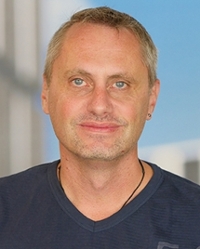13th QSC General Assembly in Amsterdam
We cordially invite you to the 13th General Assembly of the Quantum Software Consortium (QSC), which will take place in Amsterdam on 12 June 2025. It will be organised by Tim Coopmans (QuTech, TU Delft) and Arghavan Safavi-Naini (QuSoft, IoP, UvA). There will be several presentations ranging from mathematics, cryptography and quantum information to experimental quantum optics. Serge Fehr (CWI, UL), Krystal Guo (KdVI, UvA), Álvaro G Iñesta (QuTech, TUD), Mariagrazia Iuliano (QuTech, TUD) and Jeremy Young (IoP, UvA) will give talks.

Mariagrazia Iuliano (QuTech, TU Delft) Jeremy Young (IoP, UvA)

![]()

Álvaro G Iñesta (QuTech, Delft) Krystal Guo (KdVI, UvA) Serge Fehr (CWI, Leiden)
10:00 - 10:30 Coffee and welcome
10:30 - 10:40 Opening by Ronald de Wolf
10:40 - 11.20 Krystal Guo (KdVI, QuSoft, UvA) - Combinatorial constructions for quantum wires
11:20 - 11:50 Álvaro G Iñesta (QuTech, TU Delft) -
Entanglement Buffering for Scalable Networks: How Imperfect Memories Can Beat Perfect Storage
11:50 - 12:15 Junior Session (Wolfgang Löffler and students) - QSC Junior Days
12:15 - 13:30 Lunch
13:30 - 14:00 Mariagrazia Iuliano (QuTech, TU Delft) - A Quantum Internet testbed using NV centers in diamond
14.00 - 14.40 Jeremy Young (Institute of Physics, UvA) -
Symmetries in Open Quantum Systems: Autonomous Error Correction and Quantum Metrology
14:40 - 15:10 Break
15:10 - 16:00 Serge Fehr (CWI, Univ Leiden) - On the (In)security of the BUFF Transform
16:00 - 16:10 Closing by Arghavan Safavi-Naini and Tim Coopmans
16:10 - 18:00 Drinks & snacks
Serge Fehr (CWI, MI, Univ Leiden) - On the (in)security of the BUFF transform
Krystal Guo (KdVI, QuSoft, UvA) - Combinatorial constructions for quantum wires
Álvaro G Iñesta (QuTech, TU Delft) - Entanglement buffering for scalable networks: How imperfect memories can beat perfect storage
Mariagrazia Iuliano (QuTech, TU Delft) - A quantum internet testbed using NV centers in diamond
Jeremy Young (IoP, UvA) - Symmetries in open quantum systems: Autonomous error correction and quantum metrology
Serge Fehr (CWI, MI, Univ Leiden) - On the (In)security of the BUFF Transform
Digital signatures play an indispensable role in modern cryptography, both in the theory and in practical applications. The gold standard security property for digital signatures is "unforgeability" (under chosen message attacks), demanding that it is computationally infeasible to produce a valid signature without knowing the secret key. However, in applications, possibly designed by software engineers that don't have a rigorous understanding of cryptographic security, digital signatures may be slightly abused and their security guarantee (unknowingly) overstretched. In the worst case, this results in insecure applications.
Motivated by such (potential) non-standard uses of digital signature schemes in complex applications, the latest NIST call for post-quantum secure signature schemes explicitly recommends additional security properties (beyond standard unforgeability). As a consequence, several of the NIST submissions (explicitly or implicitly) employ the BUFF-transform, which is a generic way to obtain these additional security properties - at least that was the common belief...
In a recent line of work, we show that the situation is actually more complicated, in that one of these additional security properties (called "non-resignability") turns out to be rather elusive. Concretely, we observe that the original analysis of the BUFF transform is incorrect, and we argue that non-resignability in its original formulation is actually (almost) unachievable; in particular, it is not achieved by the BUFF transform, thus invalidating prior such claims. We then consider a slightly weaker variant of the formal definition of non-resignability, which circumvents the negative result, and we show that whether the BUFF transform achieves this variant depends on subtle details.
Jeremy Young (IoP, UvA) - Symmetries in Open Quantum Systems: Autonomous Error Correction and Quantum Metrology
Quantum systems are crucial to developing new technologies and studying fundamental science. However, current systems cannot be fully isolated from the environment, which can introduce detrimental noise effects that
destroy useful quantum features in these open quantum systems. Nevertheless, in some circumstances it is possible to instead utilize the environment as a resource via symmetries. Although the implications
of symmetries in Hamiltonian systems are well-understood, in open quantum systems the situation is more complex.
In this talk, I will show how two classes of symmetry exist for open quantum systems, “weak” and “strong”, and I will demonstrate the utility of strong symmetries via two examples. First, I will identify connections between steady state phase transitions and autonomous error correction, a form of quantum error correction in which active measurement and feedback is no longer needed. Second, I will show how strong symmetries allow for the preparation of highly-entangled collective states known as spin-squeezed states, which can be experimentally realized in optical cavity systems for quantum-enhanced metrology.
Krystal Guo (Korteweg-de Vries Instituut, QuSoft, UvA) - Combinatorial constructions for quantum wires
Abstract: Perfect state transfer was proposed as type of "quantum wire"; as a part of a quantum algorithm, one may want to transfer a state from one qubit to another qubit. While this could be done using a series of swap gates, such an operation might be prone to noise. This motivated the idea that one could construct a time-evolution quantum process that would perform the state transfer. Since its introduction in 2003, state transfer has been studied extensively with tools from algebraic graph theory and has let to many interesting combinatorial problems.
In this talk, we introduce peak state transfer—a generalization of perfect state transfer -- in both continuous and discrete-time quantum walks, which quantifies the maximum state transfer achievable under unitary evolution even when perfect state transfer is out of reach. Using a spectral characterization, we can determine this completely for some families of graphs, including an infinite families where the amount of peak state transfer tends to 1 as the number of vertices grows. We will highlight the combinatorial connections and matrix techniques used. This is based on joint work with Vincent Schmeits.
Álvaro G Iñesta (QuTech, TU Delft) - Entanglement buffering for scalable networks: How imperfect memories can beat perfect storage


